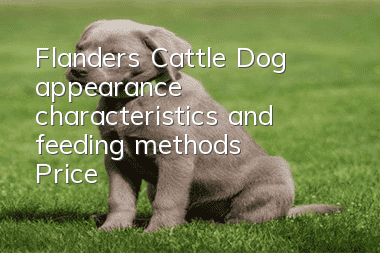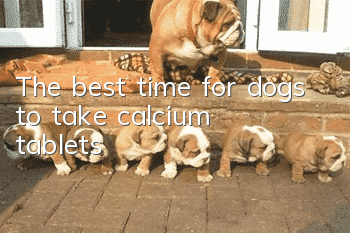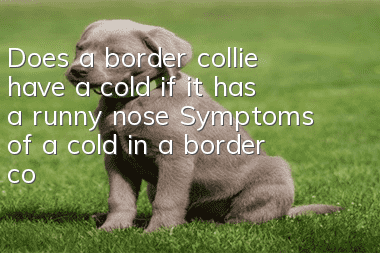Flanders Cattle Dog appearance characteristics and feeding methods | Price

The Flanders Cattle Dog is one of the most outstanding cattle dogs in Western Europe. It is native to Belgium and originated in the 17th century. The current main uses are as guide dogs, guard dogs, and search dogs. The Flanders Cattle Dog has thick, coarse hair all over its body and is native to the border areas of France and Belgium. Before the 19th century, many breeds similar to shepherd dogs existed on the Belgian border. Dog fans bred these dog breeds and improved them into four basic dogs of different colors. Before the 20th century, the Belgian Shepherd Dog was widely used around Belgium. The Flanders Cattle Dog was officially recognized in 1912.
1. Characteristics of the Flanders Cattle Dog
(1) Appearance characteristics
Size - The height of an adult Flanders Cattle Dog is 58cm-69cm at the shoulder, and the weight is 27kg-40kg. The Flanders Cattle Dog is a powerful, compact, short-coupled, rough-coated dog with a very pronounced rough coat, which is its main appearance. The Flanders Cattle Dog gives the impression of being very powerful, but without any feeling of heaviness or clumsiness in its overall structure.
Head - The head of the Flanders Cattle Dog has good proportions, especially the beard and moustache, and is in good proportion to the body structure. The Flanders Cattle Dog has a bold and alert expression, with ears set high and wide. The inner and outer corners of the eyes are on the same straight line. The eyes are oval, dark brown, and have black eye circles. The nostrils are open, the cheeks are flat and sloping, the mouth is dry and close fitting. The upper and lower jaws are of equal length and strength, and the chin is broad and strong.
Trunk - The first rib of the Flanders Cattle Dog is slightly curved. The ribs are well sprung and sloping back, giving the correct depth to the chest. Both front and rear feet are rounded, compact, and turn neither outward nor inward. The Flanders Cattle Dog's toes are close, well-arched, black, and strong. The pads of the feet are thick and hard, the limbs are strong, broad and short, the chest is broad and deep to the elbow. Ribs deep and well sprung. The topline is smooth, with ample volume, and the overall effect of the body is stout and powerful. The tail is medium set, neither very high nor very low.
Hair - The Flanders Cattle Dog's back hair is rough and messy, with two layers of hair. The inner hair is fine, soft, and relatively dense. There can be slight trimming to highlight the contours of the body. The upper back coat feels rough, dry, and matted but not curly. The hair on the head is short, and the hair on the upper part of the back is particularly dense but still maintains that rough feel. The hair on the ears is coarse and thick, and the undercoat is fine and dense. The coat colors are mainly camel to black, salt and pepper, gray, tabby and so on.
(2)Characteristics
The Flanders Cattle Dog is very agile and brave. The character shows a calm mind and good behavior. A stable character is a good candidate for cattle herdingThe first important reason is that this kind of dog can perform very well at work because of its firm willpower and brave character. A vigilant attitude, a brave personality, and a gentle temperament are the rare and excellent qualities of the Flanders Cattle Dog.
2. How to raise Flanders Cattle Dogs
As a large cattle breed, the Flanders Cattle Dog is obviously not suitable for urban breeding. Flanders cattle dogs are raised in the same way as shepherd dogs. They are fed a little cooked meat and some easily digestible whole grains. At that time in Belgium, Flanders Cattle Dogs ate in the wild when working. This kind of dog has super adaptability. A certain amount of time of outdoor exercise is needed every day to meet the dog’s exercise needs and help digestion.
3. Flanders Cattle Dog Training
Reward and punishment training - Rewards and praise should be less. Too much praise will only confuse the dog. Punishment must not include corporal punishment. This will only make the dog feel insecure from an early age, and will also make the dog fearful and obedient. Use a water gun to stop disobedience during training and shout orders. After growing up in an unsafe environment, they will become very aggressive.
Excretion training - defecation training should be carried out when puppies are young to develop this awareness. Put it where it should go and reward it with food after defecation. If you don't find the right place, scold it to make it realize that this is wrong and will not make the owner happy. After a few times, it will develop this habit.
Food stimulation - Food selection should use pet-specific snacks, and the amount of reward should be very small to avoid affecting body weight. After asking the dog to perform an action, use food as a reward to induce the dog to do this fixed training. Food stimulation can effectively mobilize pets' training enthusiasm and quickly complete relevant actions.
4. Price of Flanders Cattle Dog
The price of Flanders Cattle Dog puppies is around 1,000-2,000 yuan, and the price of adult Flanders Cattle Dogs is more than 3,000 yuan. This kind of dog has a good physique, but the hair makes the overall feeling rough. It is a good choice as a herding dog, but due to its relatively gentle personality, it is not suitable to be raised as a guard dog or a watchdog.
Guess you like it
Hericium Terrier, Rottweiler, Norwegian Terrier, Czech Terrier, Tibetan Terrier
- What should I do if my puppy has diarrhea? What medicine should I take?
- Are King Charles spaniels lively?
- What should I do if my Russian Shepherd vomits after eating too much?
- Why does a dog keep panting despite no strenuous exercise?
- What is the best way to deal with golden retriever hair loss?
- How to stop a dog that likes to chase cars?
- I couldn’t help but give my February dog a bath.
- What should I do if my dog eats preservatives?
- What are the symptoms of Husky cold?
- How to train a Corgi? You need to learn as a poop shoveler!



